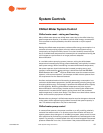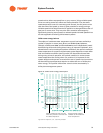
84 Chiller System Design and Control SYS-APM001-EN
System Issues and Challenges
Retrofit Opportunities
A tremendous retrofit opportunity can be realized if the low-flow concepts
discussed in the chapter “System Design Options” on page 27 are utilized.
Building owners may need to increase the capacity of an existing system, for
example, in response to a building addition. In many of these buildings, the
condenser water system (piping, pump, and tower) is in good condition, but
is considered to be too small. By changing from traditional design conditions,
the existing infrastructure can often be used while still providing additional
capacity. A detailed discussion of this starts on page 37.
Applications Outside the Chiller’s Range
Designers may wish to use chillers to provide cooling for which the flow rate
or temperature requirements are not within the allowable ranges of a
particular chiller, even though the chiller has adequate capacity. This often
occurs with manufacturing processes. Let’s look at two examples showing
system designs that can satisfy the desired conditions.
Flow rate out of range
A plastic injection molding process requires 80 gpm [5.1 L/s] of 50°F [10°C]
water and returns that water at 60°F [15.6°C]. The selected chiller can operate
at these temperatures, but has a minimum flow rate of 120 gpm [7.6 L/s]. The
following system in Figure 51 can satisfy the process. Decoupling the chiller
from the process load allows the water flow to be different, ensuring that the
flow through the chiller is within acceptable limits. With a single chiller
system, one pump and a three-way valve gives the same results.
Figure 51. Flow rate out of range for equipment
Process
Load
50°F [10°C]
80 gpm [5.1 L/s]
Constant Volume Pump
50°F [10°C]
40 gpm [2.3 L/s]
60°F [15.6°C]
80 gpm [5.1 L/s]
Constant Volume Pump
120 gpm [7.6 L/s]
56.7°F [13.7°C]
120 gpm [7.6 L/s]
50°F [10°C]
120 gpm [7.6 L/s]
Bypass
Pipe
Chiller


















